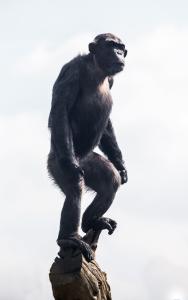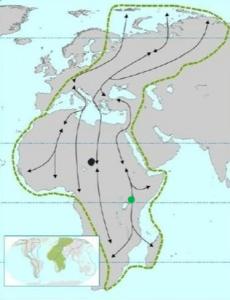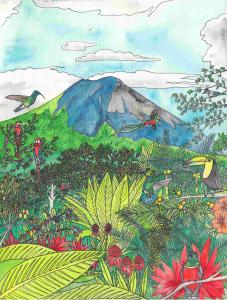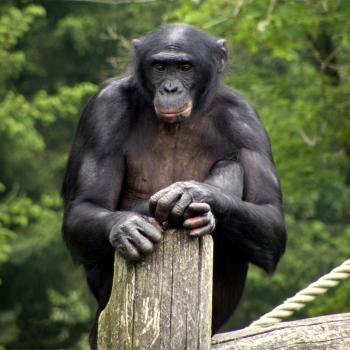
Exploring why our most distant ancestors stood up on two feet is the human creation story. It’s among the greatest mysteries left to solve. New evidence suggests birds may have played a role.
For decades scholars believed what lit the fuse on human development was bigger brains, but the current consensus is that walking upright was the crucial turning point. Recent studies found several primate species stood up on two feet more than two million years before the brain started evolving. Perhaps bipedalism was somehow a contributing factor in the evolution of the brain.
Homo erectus became the first road-tripper about 1.8 million years ago, trekking from Africa to India and China, but the more vexing question is why bipedalism evolved among primates two to four million years earlier – primates that never left Africa. But first a cautionary note about the entire enterprise: With meager evidence at hand, it’s tempting to slip into myth making.
A good journalist would ask whether science and the public in general could be tempted by narratives that reinforce our contemporary identity as a species. Science or no science, the space for myth making is created when it’s virtually impossible to explain a major event in the distant past, and bipedalism qualifies.
Many primates were bipedal
Before the fossil record began providing real answers, scholarly theories on bipedalism imagined an early human species going through a linear progression of evolutionary change – remarkably similar to the western view of how the world works.
But over the last 60 years the fossil record found bipedalism across numerous primate species living at different times and in a range of environmental conditions. One scholar warned against a narrow-minded approach to the subject, in the diplomatic language of academia.
“Although perhaps controversial, it is important that when considering such a unique adaptation as bipedalism, we do not allow that uniqueness to imply that there was ever only one successful mode of bipedalism in our hominin ancestry,” wrote paleontologist W.E. Harcourt-Smith in a 2004 study published in the Journal of Anatomy. “In light of the richness of recent findings in the hominin fossil record, it is important to ask the question of whether the evolution of bipedalism was a more complex affair than has previously been suggested.”
Indeed, are we ready to discover a reason for bipedalism that doesn’t fit into a celebratory narrative of human origins? How about a solution that’s culturally distasteful? One thing is certain, the subject of bipedalism has inspired about 100 scholarly studies over the last 75 years, according to the definitive work on the subject, First Steps: How upright walking made us human (2021, HarperCollins) by Jeremy DeSilva. Few studies have been taken seriously, DeSilva wrote, including claims that primates needed their hands free to punch each other or that bipedalism evolved from the need to spontaneously run from forest fires.
The primate housewife theory
Despite Harcourt-Smith’s caution, anthropologist C. Owen Lovejoy of Kent State University linked bipedalism to the origin of monogamy in a 2016 study. Lovejoy argued that when climatic pressure made food scarce, an exclusive bond formed between food-gathering males and child-bearing females. To make it work, males needed their arms free to carry food.
First, it’s important to remember that primates existed for nearly 50 million years before bipedalism emerged, during which time the climate zig-zagged all over the place. A range of primate species barreled through dozens of dramatic global climate changes before deciding to stand up on two feet. Food was plentiful. Food was scarce. Bipedalism only emerged about six million years ago.
Secondly, the monogamy theory reflects a continued male blindness in academia – it doesn’t account for females. Presumably male primates are delivering food to the primate “wife,” who could go on raising the young as she always did. Mr Lovejoy seems to have overlooked what motivated females to stand up on two feet.
Third, the male-primate-carrying-things-for-his-girl theory, which dates back to Darwin, has the pungent odor of a self-serving western narrative. It appears to be a scholarly sanctification of marriage based on the conclusion that humans have been naturally monogamous for several million years.
More theories bite the dust
A theory linking bipedalism to an increase in Africa’s open grassland habitat emphasized that walking was a more efficient way to travel across savannas. Some argued that standing up provided a better line of sight across open ground. One scholar suggested standing up helped dissipate body heat.
But the savanna theory was mortally wounded when the fossil record revealed that bipedalism evolved in the forest, a couple of million years before savannas became predominant. The line of sight theorists had to acknowledge that standing up for a better view also makes it easier for predators to spot you. If you want a good line of sight, climb a tree. You meet even catch a breeze up there.
What were our ancestors thinking?
Charles Darwin argued that freeing up the hands to carry objects, make tools and carry weapons was likely the evolutionary advantage that caused bipedalism. Under the Darwinian canopy, science still frames bipedalism as some kind of uniquely human adaptation.
The idea is that bipedalism solved some kind of problem, got around some limiting obstacle and improved our chances to survive and thrive. After all, adaptation is the defining trai mt of the human species, right?
But bipedalism isn’t like a genetic mutation allowing a frog to camouflage itself. A living, breathing primate had to be motivated to stand up on two feet, to walk, perhaps to run. Why?
Considering that bipedalism is an affront to the spine that inevitably leads to back pain, there had to be a very strong motivation for standing upright. Forcing the spine to do something it wasn’t built for suggests a uniquely powerful force in evolutionary history.
Perhaps bipedalism was not an adaptive response at all. Maybe it’s time to explore other fundamental aspects of human nature that could have contributed to such profound evolutionary change.
Humans are the best imitators
One of the most powerful tools in the animal kingdom is imitation, and according to Aristotle, humans are “the most imitative creatures in the world … ” Turns out he was right – scholars recently found we have an over-developed talent for imitation that’s been key to our evolutionary success.
“Human beings are the premier imitators on the planet,” said Andrew Meltzoff, co-director of the University of Washington Institute for Learning and Brain Sciences, in a 2017 feature story in The Christian Science Monitor. Recent studies found that humans “over-imitate,” meaning they copy a series of tasks exactly even if some steps are clearly not necessary. Apparently it’s the glue of what a growing school of anthropologists call “cumulative culture,” allowing people to continually build on already complex practices.
While other animals learn by imitation, researchers have found they will discard tasks that are unnecessary to achieve the goal at hand. In contrast, humans will perform seemingly irrational steps without question, which helps explain how esoteric rituals and oral histories were successfully passed down over extended periods of time.
Although we don’t like to celebrate it, imitation has defined much of human history. A 2013 study at MIT concluded that early humans imitated birdsong to develop language. Hunter-gatherers copied the migratory habits of other mammals. Predators were flushing prey long before humans copied the technique. Wearing fur was pure imitation. Humans mirror each other’s body language on the first date. The list goes on. The celebrated human capacity for adaptation was largely about selective imitation.
But no other mammal stands on two feet, or paws. Who were we imitating?
Monkey see monkey do
Birds walk on two legs. Large waterfowl like swans and geese have to run to reach take-off speed. If early humans imitated birdsong to develop language, they were already laser-focused on the avian world.
Four different species of primate stood upright in some of the busiest bird migration corridors on the continent. In Chad, Sahelanthropus tchadensis walked on two feet about six million years ago on a wintering ground of the Mediterranean-Black Sea Flyway where it converges with the East Asia-East Africa Flyway.
In central Kenya Orrorin tugenensis stood upright six million years ago, this time where three bird migration routes intersect on the Mediterranean-Black Sea and East Asia-East Africa flyways just northeast of Lake Victoria.

In Ethiopia Ardipithecus ramidus became bipedal about 4.4 million years ago on a route of the Mediterranean-Black Sea Flyway, where it overlaps with the East Asia-East Africa Flyway. In South Africa, Australopithecus prometheus walked on two feet about 3.7 million years ago in the only part of Africa where three bird flyways converge – the Mediterranean-Black Sea, East Asia-East Africa and East Atlantic flyways.

What’s the mathematical probability of four different primates choosing to walk upright over several million years in different parts of Africa, with all locations sharing one defining condition — they’re all in super-busy bird migration corridors and seasonal grounds.
Could be a coincidence. Birds are indicators of biodiversity and bountiful ecosystems. At the same time, the highly visible success of birds makes other species more likely to imitate them. Who wouldn’t want to give flying a try?

A tipping point?
Songbirds appeared about 33 million years ago in Australia and arrived in Africa about 22 million years ago, evolving for another 13 million years. The last songbirds to evolve in Africa were four species of warbler about nine million years ago.
If humans developed language by imitating birdsong it’s plausible that earlier ancestors also imitated bird sounds as a form of communication. Certainly our curious primate ancestors noticed the bright colors and virtually constant singing of migratory bird species flying around their heads every summer. Did we have an impulse to touch, grab or chase all these colorful, singing birds? Did the four species of warbler that evolved in Africa nine million years ago represent a tipping point?
Perhaps primates dreamed of flying, as humans do. After all, to fly isn’t just a romantic notion but reflects a desire for safety and security, high above the dangers of terra firma. Did the incredible range of fascinating birds in the environment somehow inspire primates to become more human, to stand up, walk and run? Did our distant ancestors wonder where the millions of colorful birds went every winter? Did we have an impulse to follow them beyond the forests and savannas to find out what lay beyond the horizon?
That would be quite a story …

(Ben H. Gagnon is an award-winning journalist and author of Church of Birds: An Eco-History of Myth and Religion, coming March 2023 from John Hunt Publishing, now available for pre-order. More information can be found at this website, which links to a YouTube video.)
















